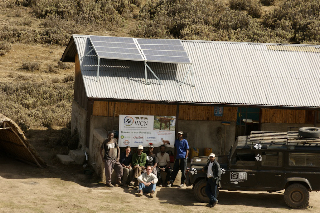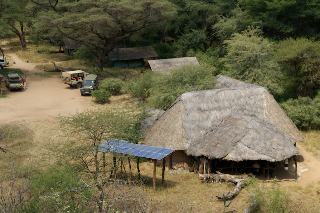Electricity can be a difficult commodity to procure in the remote areas where conservationists often work. Typically field researchers and wildlife rangers rely on gas-powered generators, which require imported fuel, often produce noxious fumes and disruptive noise, and can be costly to maintain. A better option, especially in sun-drenched parts of the world, is solar. Clean and silent, with no need for supplemental fuel, solar seems like an ideal fit for conservation work except for one major drawback: cost. But Stephen Gold – Solar and Technology Manager for Wildlife Conservation Network has been working to overcome that obstacle.
 Stephen Gold in Ethiopia in 2008 |
Over the past five years, Gold has been providing conservationists, and the communities with whom they work, with donated solar equipment. The effort is paying off with solar now powering, or soon to power, projects in isolated parts of Botswana, Ethiopia, Zimbabwe, Mozambique, Tanzania, the Gobi desert in Mongolia, and Kenya. The electricity provides lighting, drives computers and communications gear, and even helps conservationists track elephants in real-time using GPS.
However, the mission has not been easy. Challenges have included logistics, availability of equipment and funding. Still, Gold is hopeful that with support, the initiative will expand to other parts of the world.
In an August interview with mongabay.com, Gold discussed the Wildlife Conservation Network’s Solar Project.
Note: If you are interested in learning more about the Wildlife Conservation Network’s Solar Project, Stephen Gold will be available to meet at the Wildlife Conservation Network’s Expo in San Francisco on Saturday, October 3th.
AN INTERVIEW WITH STEPHEN GOLD
Mongabay: What is your background and how did you get interested in solar power?
 Stephen Gold on a working vacation in Ethiopia in 2008 |
Stephen Gold:
I have a varied background with diverse interests. I studied ancient history and classical archeology, and received a graduate degree. Through some interesting twists and turns, I became a General and Plumbing Contractor.
I first became interested in solar energy at a very young age, looking at satellites and solar cells powering small fans, but it was not until the early 1970s, that I really saw solar energy as a viable and sustainable alternative to fossil fuel.
Mongabay: How did your connection to wildlife conservation begin?
Stephen Gold:
I have traveled to a number of countries and I have always been attracted to animals and ecosystems. When you look into another being’s eyes, it changes you.
Mongabay: What was the inspiration behind providing solar power for conservationists in the field?
 Two Maasi working with Save the Elephants in Kenya |
Stephen Gold:
I attended the second Wildlife Conservation Network (WCN) Expo five years ago, and heard a talk by conservationist Rebecca Klein, who founded and runs Cheetah Conservation Botswana. She made a request for energy to maintain her project. I have a solar home in San Francisco, which I designed with electricity, hot water, and passive heat, so I thought that I could help.
Mongabay: From inception of this idea to completion of your first solar project, what was required of you and others to make this real?
Stephen Gold:
That was a long road. It started with calling local contacts, writing letters, emails, getting many rejections, and finally finding BP Solar, who gave the project a foundation. They donated all of the solar modules. Companies like Solar Depot in Petaluma, Outback Power Systems, MK Batteries, Morningstar Corp. and a local lumber company, Beronio Lumber followed, making the project a reality.
All of these companies donated materials, labor and tremendous good will, which enabled me to acquire the necessary components to put together the initial nine systems. Although I could not have done this alone, I personally put in many, many hours.
Mongabay: Now that WCN has a foothold in several countries, what’s the next step? More similar projects or larger scaled ones?
 Gitonga array at Amboseli, Kenya |
Stephen Gold:
The next step is happening right now. We are putting together systems for conservationists in Mozambique, Tanzania, Mongolia in the south Gobi desert, and Kenya. Two of these projects have power systems of over 5 KW, which is quite large. We will also be shipping out solar thermal (hot water systems), solar cookers, solar water pumps, and providing cutting edge low energy consumptions lights. This is an attempt to provide our conservationists with a “package” or paradigm of a zero carbon footprint to the best of our ability.
Mongabay: What are the biggest challenges WCN Solar faces in the near term? Long term?
Stephen Gold:
Like everyone else, funding. I have personally donated hundreds of hours and substantial amounts of money to make this project a reality. I will continue to have the same needs in the long term. More people need to understand that if we do not want our children to think of a cheetah as a mythological animal like a unicorn, we need to help people who are devoting their lives to saving them.
Mongabay: Is there a way to get the local communities to benefit where perhaps schools, clinics, etc can be established and work together with WCN’s conservationists? Studies have nearly always shown when the local populace benefits, tremendous success for wildlife conservation ensues.
 Ethiopian Wolf Conservation Project with Stephen Gold in the center |
Stephen Gold:
All of WCN’s conservationists live and work with local communities and operate on the principle that conservation efforts can only be truly successful when we understand and address the needs of the human populations involved as much as those of the endangered species. All of our conservationists undertake projects that address the economic, education and health needs of the local communities in their areas, for example:
- Save the Elephants, based in Kenya, awards scholarships to local schoolchildren for secondary education and provides material support both to local primary schools and health clinics.
- Painted Dog Conservation in Zimbabwe creates economic opportunities for local artisans to transform snare wire into art, which is sold internationally, and also works in sixteen local communities to facilitate the development of nutritional gardens for alternative sources of protein to bushmeat, improved nutrition and income generation.

Living with Lions project in Kenya
- Proyecto Tití, protecting the cotton-top tamarin monkey in Colombia, created a program in which local women weave discarded plastic bags (a ubiquitous form of waste that litters the countryside) into profitable fashion handbags, sold throughout Colombia and internationally. In addition to earning a good income, these enterprising women are also learning valuable skills in managing a small business.
- Snow Leopard Conservancy helps Himalayan villagers (whose livelihood is threatened by snow leopard attacks on their livestock) cover vital expenses, such as health care and school fees for their children, by offering homestays, solar showers, trail-side cafes and warm knitted clothing to passing trekkers.
Mongabay: Under the current administration’s push for a green economy, does WCN stand to receive any assistance for solar equipment?
Stephen Gold:
We are not sure at this time.
Mongabay: What ways can people get involved and help WCN Solar Projects?
 Save the Elephants site in Kenya |
Stephen Gold:
Visit the Solar Project website, donate to the project, meet the conservationists in person at the eighth annual Wildlife Conservation in San Francisco on October 3, and look into the eyes of the animals that we are trying to save.
Mongabay: Ideally, where would you like WCN Solar to be in five years?
Stephen Gold:
I see the project continuing, spreading to other parts of the world, and becoming an influential example of sustainable living. It is now almost 5 years old, already empowering the work of ten conservation projects, and just starting to become what I have envisioned.
If you are interested in learning more about the Wildlife Conservation Network’s Solar Project, Stephen Gold will be available to meet at the Wildlife Conservation Network’s Expo in San Francisco on Saturday, October 3th







